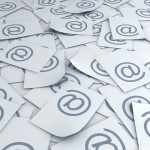Top tips from Mesmo Consultancy (and Associates) on how to save time and improve business and personal performance by ‘Taking Control of your Inbox’ and using proper business email etiquette.
Email overload is a problem for businesses of all sizes across the world. A client of mine recently upgraded his email server. While going through their requirements, an IT consultant understood that no email server was going to help them if they had no knowledge on managing their email inbox properly. Poor email management is the biggest distraction for most small businesses. So, what is the reason that made him so disappointed? The executives had no filters, no folders and more than 44,000 emails in their inbox.

Email overload
Email is one of the most ideal communication platforms in the business world. It is important for entrepreneurs to take control of their inboxes. So, don’t waste one more day running a component of your organization improperly. Here are five suggestions for arranging your inbox and boosting up your overall productivity and reducing email overload.
1. Separate Personal From Business Emails
Just like you have different accounts for personal and business finances, you must also have different email ids for every account. Family email chains during a winter reunion may really clog up the inbox. If you haven’t separated them initially, then create a new personal email id today and send a mail from your business account asking your family and friends to send all personal mails to your new email id.
2. Set Time Aside For Finding A Solution
Email is usually used every day. If there is a problem with it, you shouldn’t delay. Dedicate the time, which is needed for finding an apt solution.
3. Set Up An Email Policy For The Company
If the email system of your company needs overhauling, invite chief decision makers for a consultation to weigh in on the setup. Also, talk about your expectations regarding separating business and personal emails and response times to customers.
4. Create A Backup Plan
Did you ever think what you would do if your business mail server stopped functioning for an extended period? How are you going to interact with your vendors, customers and salesperson? Never wait for this scenario to occur. Make preparations beforehand. Copy your contacts list and put them on a different email provider’s system as a backup.
5. Create Folders
If you want to keep your inbox at zero and manage your inbox effectively, you need to make sure you have a place for putting emails that you can use for future refence. For example, I have created eight folders for corraling my emails. The folders are unsubscribe, reading, business development, today, this week, clients, office and miscellaneous.
Are you the one who struggles with managing inbox content? Then, do something about it. You can follow all the suggestions that I have mentioned above and you will see measurable improvements in efficiency, productivity and time management. Wouldn’t that be wonderful?
For more help contact Mesmo Consultancy and ask them to run one of their Brilliant Email workshops (as either a webinar or traditional class room based workshop). Too busy for either and wanting a personalised serviced. Ask them about their on-t0-one coaching.
Adriana Sopi is a freelance tech journalist based in the USA. For more information she recommends www.8acertification.net.
Tags: Brilliant Email, email best practice, email overload
Email cyber crime attacks effect one in two UK citizens and on average £247 is stolen from bank accounts per successful attack. Moreover, the Government’s Intelligence Services estimate that UK businesses are subjected to roughly 1,000 cyber attacks every hour. Email is often the low hanging fruit for the cyber criminal, rather like leaving the car keys near the front door so that the criminal can fish them out. How well do you and your business manage email security? When was the last time you updated your email best practice policy and provided any email management training?
There are two types of email security breaches, those we cause by carelessly leaking confidential information and those where others attack us. This blog deals with the former. Common cause of leaking confidential information by email (and not just during vacation time) are through:

Email security
Here are five top tips to help you manage the risk of a breach of email security and hence open the back door to a cyber crime attack especially during the vacation period.
If possible try to take an email free vacation. We all need down time. Dealing with sensitive emails over the holiday in a relaxed state of mind is often when breaches of security happen as we are at our most vulnerable. If you feel you cannot swich off it might be because you are suffering from email addiction. Click here to check if you are suffering email addiction.
Tags: email best practice, email cyber crime, email free vacation, email management, email overload, email security, out of office message
Six trillion business e-mails were sent in 2006 according to David Ferris, senior analyst of Ferris Research. Although some have predicted its death, email as the default mode of communication has only continued to increase. The two main causes of email overload are the volume of email traffic and lack of effective management. This turns a supposedly quick and convenient means of communication into something time-consuming, distracting, frustrating and ultimately counterproductive. The stress of dealing with this kind of information, hitting us from all directions equivalent to a hundred newspapers being hurled at us at once, affects both our health and state of mind. This is not all. Unsolicited or unwanted emails cost companies billions in lost revenue. But by effective traffic control and management, we can hugely reduce email overload. The benefits of this are enormous in terms of mental, physical and financial well-being.
Here are ten simple tips to achieve just this:
Above all, think if you really need to send an email. Can you pick up the phone or have a quick face-to-face chat instead? The more you send, the more you will receive, so avoid being a part of the problem.
Modern technology is supposed to save us time, enable us to work more efficiently, and make our lives less stressful and more productive. And it does. Only, we have to learn how to manage it so we are in control rather than the other way around.
Alastair is a freelance writer and has provided this article on behalf of Communicaid a culture and business communications consultancy.
What does your inbox tell you about your management style? In Tuesday’s Financial Times, Naomi Shragia wrote a compelling piece about manager’s fear of delegating. Over the years we have reviewed many senior manager’s inboxes as part of our smart email management one-to-one coaching and training programmes. An obvious source of email overload is the higher than

Too much Cc’d = Email Overload
normal volume of Cc’d email.
When asked why there is so much Cc’d email and how much is really necessary the standard reply is along the lines of ‘I need to see what is going on’. But why if you have a team you trust? Or perhaps either you don’t really trust your team (be they junior or senior managers) or they don’t believe that you trust them. Consistently, I have observed a gap between what a manger says is
his style and the reality of business culture. Most managers tell you they delegate and have developed a culture of trust and empowerment. Few acknowledge to being mico-managers. Not so judging by the amount of Cc’d email. If reality matched perceptions, they and their team would make far less use of Cc’d email.
If the culture is one of trust and empowerment, Cc’d emails is only sent either in advance of an impending crisis or to say ‘job done, crisis averted’. As Shragai points out micro-management styles and a fear of delegating holds back many business and their employees. Sadly email adds fuel to this fire by encouraging email overload through excessive and unnecessary use of the Cc address line. Most people already loose one hour a day through email misuse: add to this mico-management and we have another recipe for lost productivity and raised stress levels.
Take a look at your inbox to see just how much Cc’d email is in it. Then ask yourself how much you really need. How much is vanity and a reflection of your own lack of trust and ability to delegate? If you need some help to reduce the volume of cc’d email and save you your business time, why not call us and book a one-to-one coaching session. We guarantee to save you time. If we don’t we don’t charge you!
if you would like some help reducing the email overload and moving towards a more productive business culture why not call us and ask about our smart email management one-to-one coaching can help you and your business.
Tags: cc'd email, email management, email overload
The key to effective email management and reducing email overload is developing a process for handling each email one and once only. Make sure when you open it you do something with it. Use the 4Ds principle: Deal; Delete: Delegate or Defer. Don’t just open it, and move on leaving the email lingering in the inbox. Do this too often and by the end of the week you will have a very full inbox.
Within this process a great way to save time is to use your email software to help you. Use the keyboard shortcuts to improve your performance even more.
Keyboard shortcuts save time because you reduce the number of keystokes needed and playing hunt the menu item.
If you find these useful, then why not ask us to run a Brilliant Email Masterclasses to help you and your colleagues save time? We cover the Ds for processing emails more efficiently and software tips like these.
Meanwhile, do share your favourite keyboard short cut.
Tags: Brilliant Email, email management training, email overload, keyboard shortcuts